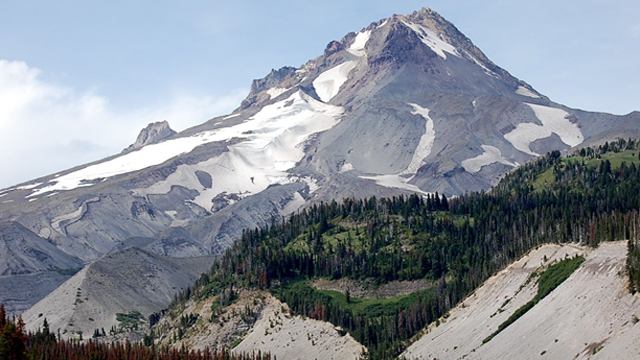Review: NOVA’s “Mt. Saint Helens: Back from the Dead”

Mt. Saint Helens erupting in 2004.
I had a chance to watch a new NOVA special that airs May 5 (PBS) on the 1980-1986 and 2004-2008 eruption cycles at Mt. Saint Helens, along with the recovery of the blast zone from the 1980 eruption. It is a fitting episode as we approach the 30th anniversary of the eruption that took out the north side of the volcano and devastated a vast swath of Cascade wilderness in Washington on May 18, 1980. Many of you have already sent me your Mt. Saint Helens memories (keep them coming!) for my tribute to the eruption, but if you want to get started on remembering that historic event and looking how the ecosystem and volcano has changed since then, this is a good place to start.
NOVA: Mount Saint Helens – Back from the Dead
Now, first, the plus side: A great deal of the footage in this episode is absolutely stunning – it is either new footage of the volcano or what looks like remastered footage of the eruptions of the 1980s. I was definitely transfixed by the shots of the eruption and the devastated area after the 1980 eruption. It was especially fun to hear from John Pallister and Dan Dzurisin (USGS) about their thoughts from both the 1980s and 2000s eruptions. I did appreciate the fact that the episode showed that a lot of geologic research involves looking at the rocks in detail to understand how they formed – when Pallister discusses the gas content of the magma, it is done in a very realistic and reasonable fashion (i.e., none of this “shocking discovery” nonsense that plagues many documentaries lately). The ecological side of the story was interesting, albeit a little fluffy. Again, the footage of Spirit Lake was great and the discussion of how rapidly it recovered was something I had not heard before this episode. Even the discussion of when St. Helens might erupt again was mostly done in a responsible fashion – I was worried at first when they quoted Pallister saying that large explosive eruptions (~10x the 1980 eruption) occur “on the order of 1000 years” and then tried to link it to the idea that St. Helens was “due” for such an event. However, they turned it back around to mention the twin, large explosive events in 1479 and 1482 AD that Pallister said shows how the volcano can produce large events only years apart – putting to rest any idea that a “recurrence interval” for large eruptions has meaning.
Now, the down side: Maybe this is more a criticism of nature documentaries on the whole today, but I am still annoyed by the “Discovery Channelization” of these shows. The quick cuts, the overbearing obsession with destruction (the “gloom-and-doom”) and the insistence on inserting unnecessary computer animations just distracts from the really interesting story about the volcano. There is an overemphasis of Saint Helens as being a “threat” (usually accompanied by ominous drumbeats) to mankind, calling it a “ticking timebomb” – just unnecessary in my opinion. My gold standard for volcano documetaries is still “In the Path of a Killer Volcano” on Mt. Pinatubo, which might have been made long enough ago to compare, in that that documentary, they let the geologist and Air Force personnel ramp up the excitement rather than artificially augmenting it with MTV-style production and 2012-like doomsday prognostication.
Some of the science in the episode was played a little loose for my liking as well – much of the events leading up to the 1980 and 2004 eruptions were glossed over in such a way as to suggest they came out of the blue (especially in regard to the 1980 event). Some of the connections that were implied, such as the length of time to build up gas pressure is directly related to an eruption and that only explosive events are “eruption” were a little glaring. Also, the explanation and graphic for subduction-zone magmatism was, well, appalling. Sorry to say it, but it might have been the worst I’ve seen in a long time – implying some huge, bubbling vat of liquid as thick as the crust underneath the Cascades, with a conveyor belt of magma coming from what I think was supposed to be the Juan de Fuca plate … but you got me. Luckily, it was only briefly used in the episode. The same might be said for the graphic on the “Ring of Fire”, which implied that the entire Hawaii-Emperor Seamount Chain is active, but again, it was only briefly used.
Overall: All that being said, I actually enjoyed the episode – one of the first to connect the 1980 eruption, the post-1980 recovery and the 2004-08 activity into a single thread about the active volcano. It definitely gives viewers the impression that events like the 1980 eruption are not “out of the ordinary” at a volcano like Mt. Saint Helens, but instead that we should expect that volcanoes will have violent eruption – and life will recover, likely faster than we could imagine. It really is the footage of Saint Helens that is the star of the episode, letting people see how much the volcano has changed since the 1980 eruption, up close and personal.
Grade: B(Well worth watching, but watch out for some of the tone and loose science).
Disclaimer: I was sent a copy of the video to watch from WGBH.
